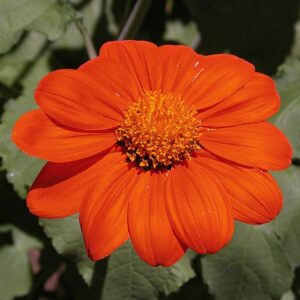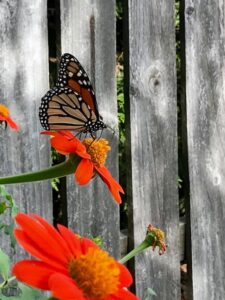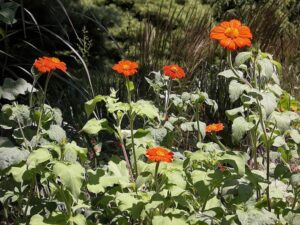Tithonia Rotundifolia (Mexican Sunflower)
go.ncsu.edu/readext?1072842
en Español / em Português
El inglés es el idioma de control de esta página. En la medida en que haya algún conflicto entre la traducción al inglés y la traducción, el inglés prevalece.
Al hacer clic en el enlace de traducción se activa un servicio de traducción gratuito para convertir la página al español. Al igual que con cualquier traducción por Internet, la conversión no es sensible al contexto y puede que no traduzca el texto en su significado original. NC State Extension no garantiza la exactitud del texto traducido. Por favor, tenga en cuenta que algunas aplicaciones y/o servicios pueden no funcionar como se espera cuando se traducen.
Português
Inglês é o idioma de controle desta página. Na medida que haja algum conflito entre o texto original em Inglês e a tradução, o Inglês prevalece.
Ao clicar no link de tradução, um serviço gratuito de tradução será ativado para converter a página para o Português. Como em qualquer tradução pela internet, a conversão não é sensivel ao contexto e pode não ocorrer a tradução para o significado orginal. O serviço de Extensão da Carolina do Norte (NC State Extension) não garante a exatidão do texto traduzido. Por favor, observe que algumas funções ou serviços podem não funcionar como esperado após a tradução.
English
English is the controlling language of this page. To the extent there is any conflict between the English text and the translation, English controls.
Clicking on the translation link activates a free translation service to convert the page to Spanish. As with any Internet translation, the conversion is not context-sensitive and may not translate the text to its original meaning. NC State Extension does not guarantee the accuracy of the translated text. Please note that some applications and/or services may not function as expected when translated.
Collapse ▲Tithonia rotundifolia (Mexican Sunflower)
Article by Extension Master Gardener℠ volunteer Kathryn Copley
Mexican Sunflower is a low-maintenance annual that tolerates deer, drought, heat, and dry soil and has moderate salt tolerance. Showy in the garden, it is also a good cut flower.
It is fast-growing (3- to 6-ft. tall and 2- to 3-ft. wide) with plenty of orange-red 3-in. blooms that attract bees, butterflies and hummingbirds from mid-summer to fall.
Plant Tithonia rotundifolia in full sun in average, well-drained soils. Avoid rich soil or heavy fertilization, both of which promote excess foliage and weak stems. Pinch back plants to encourage sturdier, bushier growth. Sturdier plants are less likely to fall over but plants may need to be staked. Stems can be brittle, so shelter plants from strong winds if possible. Dead-head to prolong the bloom season.
Use this plant in the back of the border in cutting gardens, drought tolerant gardens and pollinator gardens. For a high-energy planting, use in mixed or annual borders with tall zinnias, coreopsis, and other flowers in hot colors. Or tone down the brilliant orange-red flowers by combining with purple flowers and larger plants with dark-colored foliage.
Mexican Sunflower has no serious insect or disease problems, but watch for slugs and snails.
Only a few cultivars are generally available:
- ‘Torch’ – the most commonly offered cultivar, winner of an All-American Selection award in 1951.
- ‘Fiesta del Sol’ – a shorter cultivar, growing about 3-ft tall.
- ‘Goldfinger’ – 2 to 2 1/2-ft tall with orange-gold flowers.
- ‘Yellow Torch’ – with apricot yellow-orange flowers.
The flowers are followed by grey to black, flattened triangular seeds that are easy to collect for future planting. Sow seeds directly in the garden at last frost date or, for earlier bloom, start them indoors 6 to 8 weeks before the last frost date. Thin plants to at least 2-ft. apart.
Resources
- NC Extension Gardener Plant Toolbox: Tithonia rotundifolia (Mexican Sunflower)
- Home & Garden Information Center: Growing Annuals
- Wisconsin Extension Center: Mexican Sunflower Tithonia rotundifolia
By Kathryn Copley, Extension Master Gardener SM Volunteer, Brunswick County, NC. For more information on gardening in Brunswick County, please call the Brunswick County Cooperative Extension Office 910-253-2610






